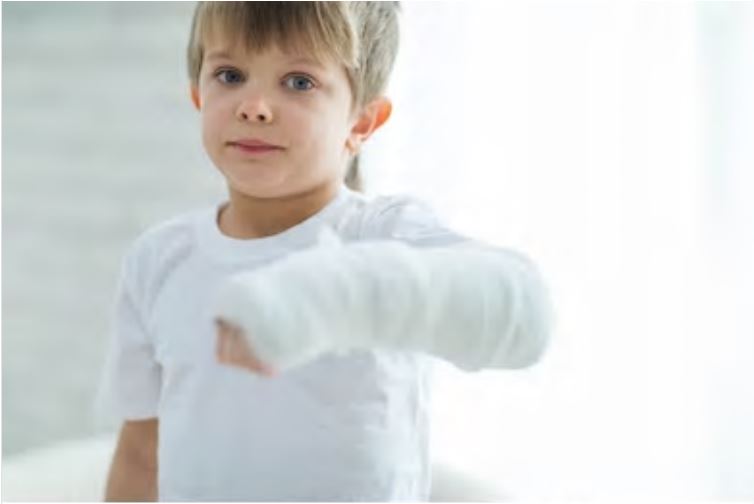
Children and Fractures by Colleen Kraft, M.D.

Although the term fracture may sound serious, it is just another name for a broken bone. Fractures are a very common injury among children under age six. Falls cause most of the fractures in this age group.
A broken bone in a child is different from one in an adult, because young bones are more flexible and have a thicker covering, which makes them better able to absorb shock. Children’s fractures rarely require surgical repair. They usually just need to be kept free of movement, most often through the use of a molded cast.
Most broken bones in children are either “greenstick” fractures, in which the bone bends like green wood and breaks only on one side, or “torus” fractures, in which the bone is buckled and twisted but not completely broken. A “bend” fracture refers to a bone that is bent but not broken. “Complete” fractures, in which the bone breaks all the way through, also occur in young children.
There are three types of fractures that may require surgery. A “displaced” fracture, where the ends are separated or out of alignment, an elbow fracture, or a fracture through the child’s growth plate (an area at the end of the bone that regulates further growth) may require surgery and longer term follow up by an orthopedic surgeon.
 Fractures also are classified as “non-displaced,” when the broken ends are still in proper position, or “displaced,” when the ends are separated or out of alignment. In an “open” or “compound” fracture, the bone sticks through the skin. If the skin is intact, the fracture is “closed.”
Fractures also are classified as “non-displaced,” when the broken ends are still in proper position, or “displaced,” when the ends are separated or out of alignment. In an “open” or “compound” fracture, the bone sticks through the skin. If the skin is intact, the fracture is “closed.”
Signs and Symptoms:
It’s not always easy to tell when a bone is broken, especially if your child is too young to describe what he’s feeling. Ordinarily with a fracture, you will see swelling and your child will clearly be in pain and unable—or unwilling—to move the injured limb. However, just because your child can move the bone doesn’t necessarily rule out a fracture.
Home Treatment—Until your child can be examined:
- You can use an ice pack with a child older than two; cold can cause skin injury to the delicate skin of younger children.
- Do not give the child anything by mouth to drink or relieve pain without first consulting your doctor.
- If part of the injury is open and bleeding, or if bone is protruding through the skin, place firm pressure on the wound; then cover it with clean (preferably sterile) gauze. Do not try to put the bone back underneath the skin. Call 911 and let paramedics supervise transportation and help make your child comfortable.
- Until your child can be seen in the pediatrician’s office, emergency room, or urgent care center, use an improvised sling or rolled-up newspaper or magazine as a splint to protect the injury from unnecessary movement.
Professional Treatment:
After examining the break, the doctor will order X rays to determine the extent of the damage. If the doctor suspects that the bone’s growth plate is affected, or if the bones are out of line, an orthopedic consultation will be necessary.
Because children’s bones heal rapidly and well, a plaster or fiberglass cast, or sometimes just an immobilizing splint, is all that is needed for most minor fractures. For a displaced fracture, an orthopedic surgeon may have to realign the bones. This may be done as a “closed reduction,” in which the surgeon uses local or general anesthesia, manipulates the bones until they’re straight, and then applies a cast. An “open reduction” is a surgical procedure done in an operating room, but this is rarely necessary for children.
Usually casting brings a decrease in pain. If your child has an increase in pain, numbness, or pale or blue fingers or toes, call your doctor immediately. These are signs of swelling. To relieve the pressure, the doctor may split the cast, open a window in it, or replace it with a larger one. You should also let your doctor know if the cast breaks or become wet and soggy, as the cast needs to be intact to help the bone heal.
Bones that have been broken will sometimes form a hard knot at the site of the break during the healing process. As the bone remodels, it will resume its normal shape within in a few months.
The information provided is for general interest only and should not be misconstrued as a diagnosis, prognosis or treatment recommendation. This information does not in any way constitute the practice of medicine, or any other health care profession. Readers are directed to consult their health care provider regarding their specific health situation. Marque Medical is not liable for any action taken by a reader based upon this information.
